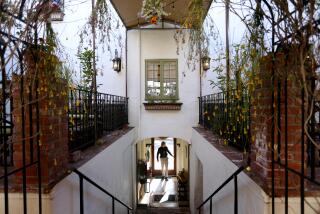Coastal Panel Rejects San Simeon Resort Plan
SAN LUIS OBISPO — The California Coastal Commission rejected a Central Coast plan late Thursday that would have allowed the Hearst Corp. to build a large oceanfront resort complex along one of the most scenic and undisturbed sections of the state’s coastline.
In its 9-3 vote, the commission rejected an effort by San Luis Obispo County supervisors to ease coastal regulations on new development, which would have accommodated the Hearst Corp.’s 650-room resort and oceanside golf course, along with other building projects in the same region.
The majority of the commission accepted its staff’s conclusions that the county’s plan would violate Coastal Act protections of scenery, wildlife, agriculture--and especially water, which is in short supply here.
At the same time, it accepted the staff’s recommendation that the project could go forward if it were reduced substantially--375 rooms instead of 650, no golf course and virtually all of the development concentrated in one area at the base of San Simeon Point.
An audience of close to 200 people applauded the commission’s vote with a standing ovation.
“This action sends a clear, strong message to the county supervisors and the Hearst Corp.: Go back, rethink this and come back with something that meets the protections of the Coastal Act,” said Susan Jordan, a member of the League for Coastal Protection, one of half a dozen environmental groups that were fighting the county plan and the Hearst development.
The commission’s vote followed dramatic testimony from two members of the Hearst family, who urged panel members to reject the resort near the family’s famous castle in San Simeon. The name Hearst has been closely identified with the spectacular, solitary stretch of coastline south of Big Sur for more than 130 years.
Patricia Bell Hearst, the former wife of George Hearst--the chairman of the board of the Hearst Corp.--drove up from her home in the Los Angeles area to register her objections to the proposed resort.
Recalling “a decade of summers at San Simeon, eating and sleeping in the old ranch house . . . galloping through towering, majestic trees,” she sobbed briefly and then pleaded,: “In my heart, I pray that today you will vote for our state, our country and for the world’s most majestic coast.”
Her former husband, a leading proponent of the development--and a cousin of Patty Hearst, the heiress kidnapped in 1974--looked on impassively from the audience, as he did when a letter from another family member, William R. Hearst II, was read to the commission by a representative of the Sierra Club.
“The soul of humanity needs the quiet reference of contact with the balance and beauty of the natural world,” the letter said. “San Simeon’s peaceful beaches and unspoiled loveliness have long served my family in this way.
“My ancestors recognized and respected the native character of this exquisite coast. The clank, whir, flash, buzz and blink of commercial complexes would easily obscure, if not obliterate it.”
Philip Battaglia, a lawyer representing the Hearst Corp, downplayed the significance of the objections from some of the Hearsts, pointing out that neither Patricia nor William--who lives on the Central Coast--are members of the corporation’s board. The eight family members who serve on the board all have voted for the project, Battaglia said.
“They’re dissidents. They don’t have a vote,” he said of the others.
But their comments brought cheers from the overflow crowd attending the hearing at the Embassy Suites Hotel.
Commission members convened there to consider a coastal plan adopted by San Luis Obispo County that could allow the Hearst project and other proposed developments. The issue was whether the county’s action complied with the Coastal Act requirements.
The Hearst Corp. has hired former PGA Tour star Johnny Miller to design a Pebble Beach-like layout. The area has “golf written all over it,” Miller has said.
The county and the Hearst Corp. have six months to respond to the objections to the plan by the Coastal Commission.
“It seems unfortunate that eight years of work is resolved in less than two hours of deliberation. We obviously plan to consider all our options,” Battaglia said.
The company has been trying since 1984 to win approval for a project, which is the largest development envisioned along 100 miles of coast between Cambria and Carmel, according to Coastal Commission officials.
The site in question is a sprawling tapestry of open, undisturbed land and wildlife on a coast that has surrendered much of its natural charm to development.
Looming over it is William Randolph Hearst’s famous castle, the inspiration for Xanadu, the palatial estate in “Citizen Kane,” Orson Welles’ classic movie. It was given to the state in 1958 but the ranch below remained a Hearst Corp. holding.
Opponents had argued it would violate the Coastal Act by converting agricultural land to commercial use, by spoiling the scenery and by blocking public access to coastal bluffs and beaches.
Local critics, including some ranching families, said the project would open the floodgates to development, drive up property values and force landowners to sell out to real estate speculators.
Hearst representatives, though, said that the development would make little difference in the character of the region. They point out that it would convert only about 1% of Hearst grazing land and that all of the building would occur within a quarter-mile of the visitor center for the castle--a place that receives close to 1 million people every year.
Both sides had their unlikely allies. Representatives of unions--which generally have been bitter adversaries of the Hearst Corp.--weighed in on the side of the development. Labor likes the fact that the corporation “will be willing to pay a living wage that won’t attract a migratory work force,” said a secretary of the Building Trades Council for San Luis Obispo and Santa Barbara Counties.
Then there are the Hearsts who have joined the critics.
“George Hearst--I mean the pioneer, not my ex-husband--must be spinning in his grave to think this could happen to this beautiful land,” Patricia Bell Hearst said in an interview.
The late Sen. George Hearst began acquiring the property in 1865. His son, William Randolph Hearst, completed the famous 165-room castle in 1932.
A working cattle ranch, it has always seemed more like a kingdom by the sea as the twin towers of the castle surveyed a domain that included more than 12 miles of coastline and 77,000 acres of rolling foothills and low mountains.
Stone warehouses built by Hearst’s father in the last century are tucked in a eucalyptus grove at the base of San Simeon Point, virtually the only buildings along the 12-mile stretch of coast bordered by the Hearst ranch.
Hearst executives have been pursuing some form of development since the 1960s, when they briefly considered building a new town on the land.
More to Read
Sign up for Essential California
The most important California stories and recommendations in your inbox every morning.
You may occasionally receive promotional content from the Los Angeles Times.










